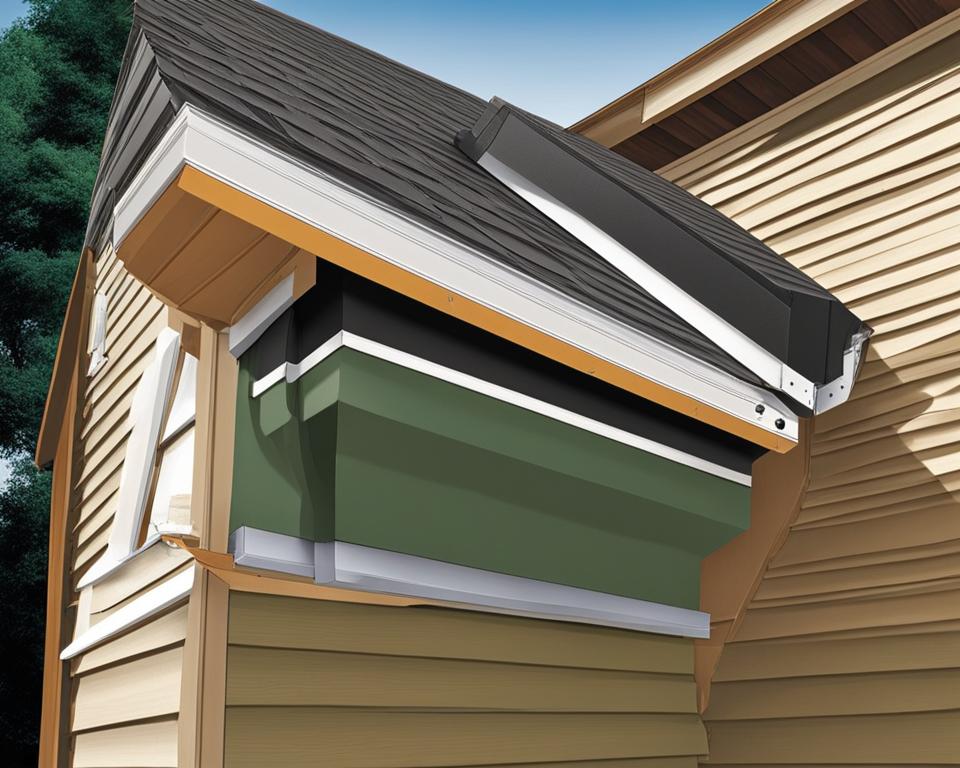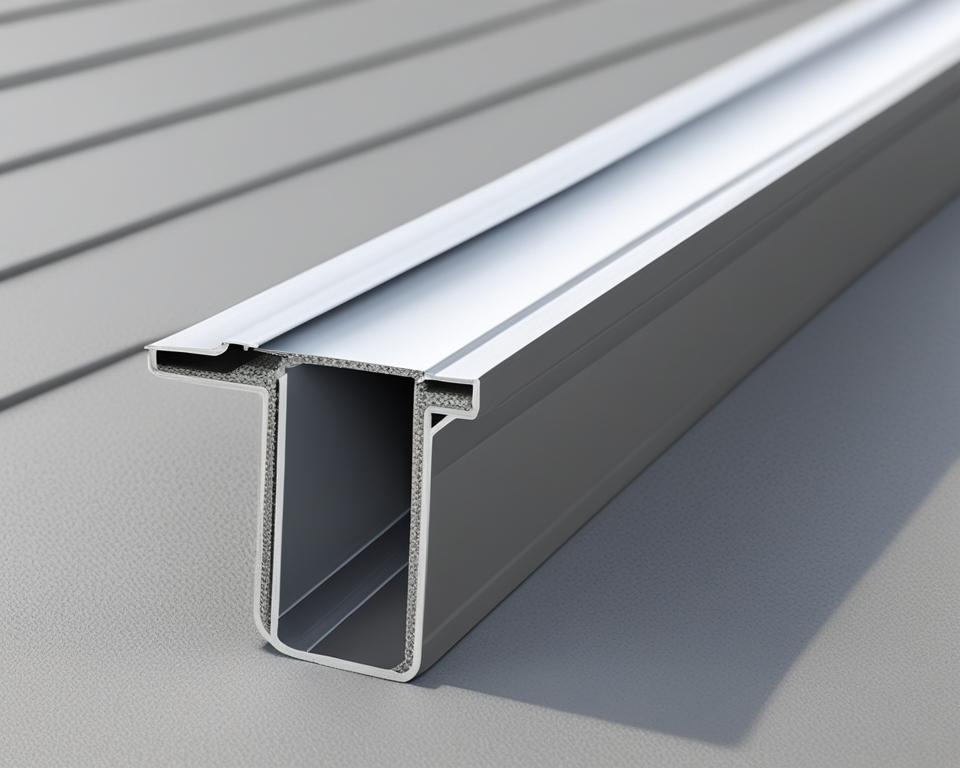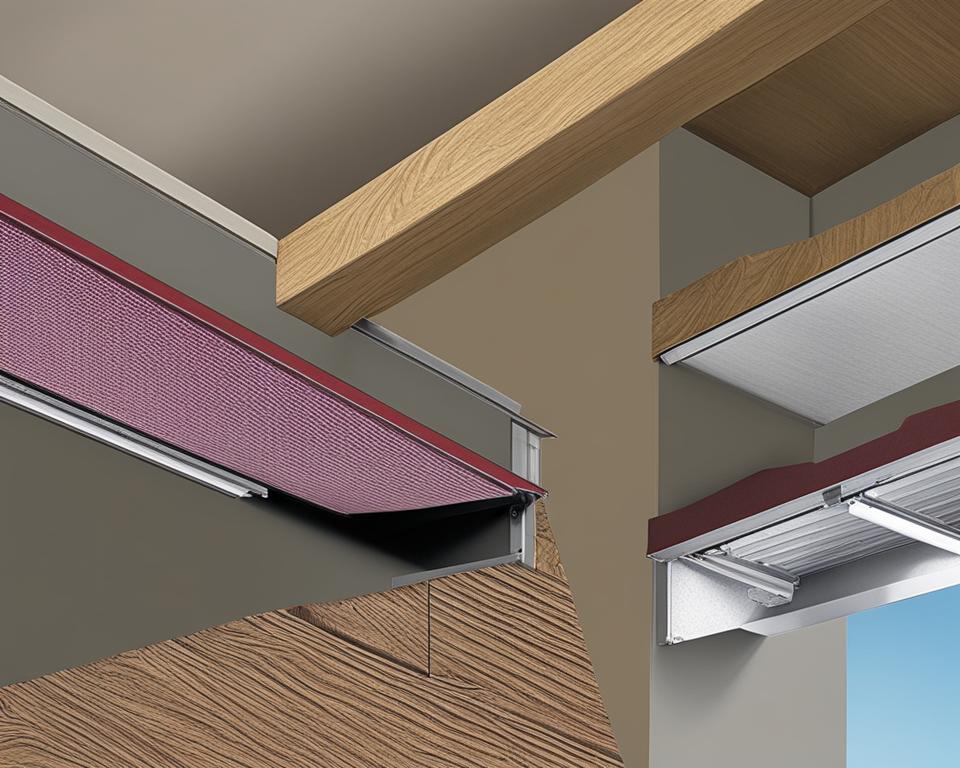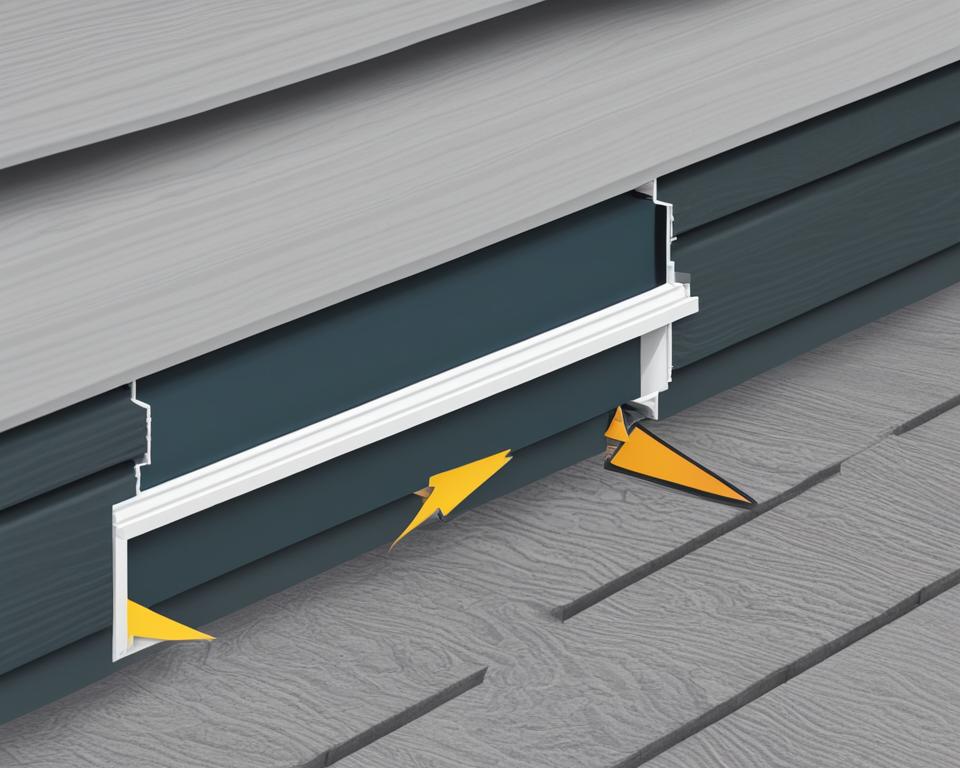When it comes to installing siding on your home, choosing the right trim is essential. Two popular options in the market are F channel and J channel. Understanding the differences between these two siding trims is crucial in ensuring a successful siding installation project.
Key Takeaways:
- F channel and J channel are both widely used in siding installation projects.
- F channel is primarily used for soffit installation, providing a shelf for the ends of the soffit pieces to rest on.
- J channel is commonly used for corners, edges, and around openings such as windows and doors.
- Builders often prefer F channel for soffit installation due to its specific design and ease of installation.
- Some contractors use J channel for soffit installation, especially if they are already using it for corners and edges.
Understanding F Channel
When it comes to siding installation, F channel plays a crucial role, particularly in soffit installation. Shaped like the letter F when viewed from the end, F channel is a type of siding trim that provides essential support for soffit pieces.
Builders often prefer using F channel for soffit installation due to its specific design and ease of installation. The trim is designed to be attached to the beams or studs of a house, creating a sturdy shelf for the ends of the soffit pieces to rest upon.
This secure placement ensures the proper alignment and stability of the soffit, making F channel an indispensable component of the soffit installation process. Whether you’re installing vinyl or metal siding, F channel is a reliable choice.

As shown in the image above, F channel provides a clean and seamless integration between the soffit and the main structure of the house, creating a visually appealing finish.
Exploring J Channel
J channel is a versatile type of siding trim commonly used for various purposes. Its narrow shape and crisp corners make it suitable for corners, edges, and around openings such as windows and doors. Not only does J channel seal off the siding, but it also helps hold the pieces of siding together, providing a clean and finished look.
The design of J channel includes a groove wide enough to accommodate the width of a siding piece. This groove serves as a channel for the siding to fit into. Additionally, there are open slots along one top edge of the J channel where nails can be placed to secure the trim firmly in place.
While J channel is primarily used for siding, some contractors also utilize it for soffit installation. However, compared to F channel, J channel requires more pieces to accomplish the same purpose. Careful consideration should be given to the specific requirements of the project before opting for J channel in a soffit installation.

| F Channel | J Channel |
|---|---|
| Primarily used for soffit installation | Primarily used for siding, corners, and edges |
| Provides a shelf for soffit pieces to rest on | Seals off the siding and holds the pieces together |
| Easier to install | Requires more pieces for soffit installation |
Despite its requirement for additional pieces, J channel offers increased flexibility when it comes to siding projects. Its use in corners, edges, and openings ensures a clean and professional finish. Contractors often make the choice between F channel and J channel based on their specific project needs and personal preferences.
Choosing Between F Channel and J Channel for Soffit
When it comes to installing soffit, choosing the right trim is crucial to ensure a seamless and durable finish. The decision often boils down to two popular options: F channel and J channel. Let’s explore the factors you should consider when choosing between these two trim types for your soffit installation.
F Channel for Soffit
F channel is a specialized trim designed specifically for soffit installation. Its unique shape, resembling the letter F when viewed from the end, provides excellent support and stability for the soffit panels. The F channel is typically attached to the beams or studs of your home, creating a secure base for the soffit pieces to rest on.
One of the key advantages of using F channel for soffit is its ease of installation. The channel acts as a shelf, allowing you to easily slide the soffit panels into place. This not only saves time but also ensures a precise and professional-looking installation.
Furthermore, F channel requires fewer pieces compared to J channel to support the soffit. This means less cutting and fitting, resulting in a more efficient installation process. If you’re a builder or contractor looking for a straightforward and reliable solution for soffit, F channel is an excellent choice.
J Channel for Soffit
While J channel is primarily used for siding, some contractors also opt for it in soffit installations, especially when they are already using J channel for corners and edges. However, it’s important to note that using J channel for soffit requires additional pieces to support and secure the soffit panels.
J channel features a narrow shape with crisp corners, making it ideal for framing and sealing off the edges of your soffit. It provides the necessary space for the soffit panels while holding them securely in place. However, the added complexity of using J channel for soffit may result in a more time-consuming installation process.

Comparing F Channel and J Channel for Soffit Installation
| F Channel | J Channel | |
|---|---|---|
| Installation Ease | Easier | More complex |
| Support and Stability | Provides solid support | Requires additional pieces |
| Pieces Required | Fewer | More |
| Suitable for Corners & Edges | No | Yes |
Ultimately, the choice between F channel and J channel for soffit installation depends on your specific requirements and preferences. Builders often prefer F channel for its simplicity and dedicated design, while contractors might consider using J channel if they are already utilizing it for other parts of the project.
Remember to assess the overall aesthetic, functionality, and ease of installation when making your decision. Choosing the right trim will ensure a professional and long-lasting soffit installation that adds beauty and durability to your home.
Conclusion
In conclusion, when deciding between F channel and J channel for siding installation, it’s crucial to consider their unique features and uses. F channel is primarily used for soffit installation, providing a solid support for the soffit pieces and making it easier to install. On the other hand, J channel is commonly used for corners, edges, and around openings such as windows and doors.
While builders generally prefer F channel for soffit due to its specific design and ease of installation, some contractors opt for J channel for its added versatility. However, it’s important to note that when using J channel for soffit, additional pieces are required to hold up the soffit and cover the edges.
Ultimately, the choice between F channel and J channel depends on the specific requirements of your siding project and personal preference. It’s recommended to consult with a professional contractor or supplier to determine the best trim option for your needs. Whether you choose F channel or J channel, both options offer reliable solutions for achieving a clean and finished look for your siding installation.
FAQ
What is the difference between F channel and J channel?
F channel is primarily used for soffit installation and provides a shelf for the ends of the soffit pieces to rest on. J channel, on the other hand, is commonly used for corners, edges, and around openings such as windows and doors.
Can I use F channel for siding installation?
F channel is typically used for soffit installation rather than siding installation. It provides solid support for the soffit pieces and is designed specifically for that purpose.
Can I use J channel for soffit installation?
Although J channel is primarily used for siding, some contractors also use it for soffit installation. However, using J channel for soffit requires additional pieces to hold up the soffit and cover the edges.
Which is easier to install, F channel or J channel?
F channel is generally considered easier to install than J channel, especially for soffit installation. It is specifically designed for that purpose and provides a solid support for the soffit pieces.
Can I use J channel for corners and edges if I already used it for soffit?
Yes, J channel is commonly used for corners and edges in addition to soffit installation. It provides a clean and crisp finish for these areas and helps hold the siding pieces together.
Which trim should I choose for my siding project?
The choice between F channel and J channel depends on your specific siding project and personal preference. F channel is preferred for soffit installation, while J channel is versatile and commonly used for corners, edges, and around openings.
